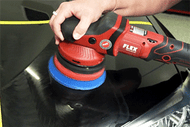How To Polish Your Car's Paint
30th Jan 2025 @ 10:16 AM
How to Polish Your Car's Paint for a Showroom Shine
In an ideal world, washing and waxing would be enough to maintain your car's finish. However, for that deep, wet-look shine, polishing is essential. While a quality paint protectant enhances your car's appearance, the true key to a flawless shine lies in proper prep work.
Why Polishing Your Car is Important
Every day, your car's paint is exposed to environmental contaminants, road debris, and oxidation, which can cause imperfections. Polishing removes swirl marks, etching, light scratches, and oxidation, enhancing gloss and preparing the surface for protection. Using the right car polish and polishing pads with a machine polisher ensures optimal results.
Understanding the Car Polishing Process
Before diving in, consider these key factors:
- Paint Condition – Assess your car’s surface for defects.
- Paint Hardness – Harder paints require more aggressive products.
- Paint Thickness – Be cautious not to over-polish.
- Application Process & Tools – Choose the right polisher and pads.
- Products – Invest in high-quality car polish for the best results.
- Time Available – Rushing leads to poor outcomes.
- Work Space – Ensure a clean, controlled environment.
- Weather Conditions – Avoid working on hot surfaces or in direct sunlight.
- Skill Level – Polishing techniques improve with practice.
Types of Car Polish and Their Uses
Always use the least abrasive polish necessary to achieve the desired result. Different polishes serve different purposes:
Step 1 – Heavy Cut Compound for Severe Defects
- Use for deep scratches, heavy swirl marks, and oxidation.
- Pair with a heavy-cut foam pad and set your machine polisher to speed 5-6.
Step 2 – Medium Cut Polish for Moderate Defects
- Best for light-to-moderate swirl marks, water spots, and oxidation.
- Apply with a medium-cut pad at speed 3-5.
Step 3 – Fine Polish for Gloss Enhancement
- Ideal for refining paint and prepping for wax or sealant.
- Use a light polishing pad at speed 1-3.
While hand polishing is possible, a machine polisher significantly improves efficiency and results.
Polishing Tips and Techniques
- Perform a test spot first – Start with the least aggressive polish and pad combination.
- Work in small sections (2'x2') – This ensures even application and thorough polishing.
- Move slowly with overlapping motions – Avoid rushing for better results.
- Keep the pad level – Prevents uneven polishing.
- Never dry buff – Work polish until it turns clear but before it dries.
- Manage the power cord – Keep it off the paint to avoid scratches.
- Use the right combination of pad, polish, and speed – Match the polish to the defect level.
- Apply slight pressure when removing defects – Just enough to be effective but without bogging down the machine.
- Never lift the polisher off the paint while it’s running – This prevents damage.
Final Step – Protect Your Work
Polish enhances your car’s appearance but does not provide protection. After polishing, apply a high-quality wax, sealant, or ceramic coating to lock in the shine and protect your car’s paint from future contaminants.
Achieve That Showroom Finish
Now that you understand the car polishing process, you're ready to transform your vehicle’s appearance. With the right tools, techniques, and patience, you’ll achieve that professional, mirror-like finish that turns heads on the road!

